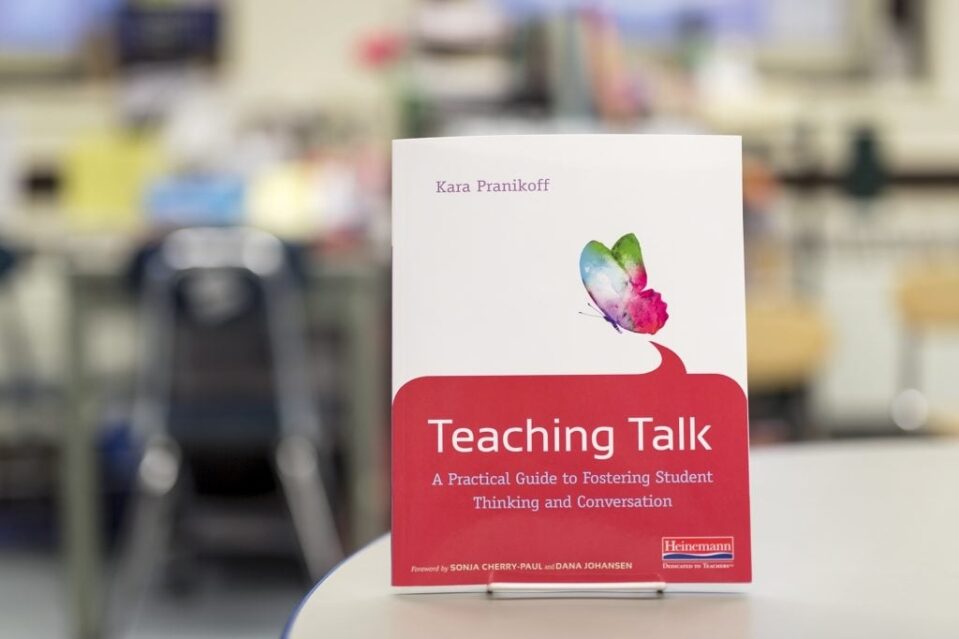
Below, read the foreword to Kara Pranikoff's Teaching Talk, written by Sonja Cherry-Paul and Dana Johansen. Sonja and Dana are the co-authors of Teaching Interpretation: Using Text-Based Evidence to Construct Meaning.
♦ ♦ ♦ ♦
Kara Pranikoff is the literacy coach teachers and students all dream of. She’s a listener, an observer, and a thinker. It wasn’t long upon first meeting Kara that we were quickly drawn into discussions about pedagogy and practice. She asked insightful questions about our classrooms, and although we discussed curriculum and challenges, our students remained at the center of our conversation. A few minutes with Kara and you know you are speaking with a literacy expert. So it’s no surprise to us that she wrote a book about cultivating talk in the classroom.
As we read Teaching Talk: A Practical Guide to Fostering Student Thinking and Conversation, we were inspired, excited, and had that tingly feeling that most teachers know well—the Yes! moment. Yes, we’ve needed this book! Yes, we need to become better at nurturing talk in our classrooms! Yes, we feel empowered and eager to implement these new strategies! As language arts teachers, we know how difficult it is to foster meaningful conversation in the classroom. Although we want our students to delve deeper into texts, we find that those discussions can fall flat or just stagnate. Try as we might to be superhero teachers, sometimes we can’t seem to break through this logjam. We need an expert who can guide us through our conversational challenges in the classroom. Kara provides that support with practical strategies for assessment, partner work, and group work. Within the pages of this book are the tools that we’ve needed to breathe new life into the talk in our classroom and our teaching of how to engender those student discussions.
If we’re being honest, as teachers we feel a sense of urgency to focus on our students’ writing and reading, not on talk. Oftentimes, we focus on the physical artifacts our students produce. We error hunt (sometimes too much!), point to areas of challenge or mastery, and mark the written works of our students, and then we implement strategies to move students forward.
But what about the conversations our students are having? How do we teach, monitor, and assess talk? Teaching these skills can seem more elusive and therefore slides to the bottom of the list of what we hope to do with our students. But doesn’t the best analysis of texts begin with student conversations?
Kara spotlights the importance of investing our teaching time to develop and deepen students’ ability to engage in discourse. She says, “It teaches students to engage in their text and their world with their eyes wide open and their minds turned on”. Such nurturing results in students developing critical thinking skills used to examine texts and the world. But how do we do this?
Kara’s work reminds us of that old adage Rome wasn’t built in a day. This work is not automatic but, instead, develops and matures with time and best practices. With this book, the tools we need to help our students’ discussions grow are at our fingertips. We learn how to focus our teacher voice during student talk time and to keep clear goals in mind. Kara teaches us how to take running records of our students’ conversations to analyze the content of the talk. These artifacts can help us answer important questions: What are our students doing? What are we doing? And what is the instruction we can provide to help students? Kara guides us step-by-step through different forms of assessment and helps us become more reflective about student discussions.
This book helps teachers navigate common dilemmas in their classrooms. Determining what to discuss is one. Kara coaches us to help students self-generate conversation topics; we start to understand which ideas can be sustained and broadened beyond the specifics of a text, and which ideas will result in sparse talk limited to retellings of a text. Dialogue requires reflection.
Determining how to talk is another challenge. Like seeds with a potential to blossom into a thriving garden, Kara reminds us to start small, with partnerships or small-group conversations, and then build up to whole-group discussions. Dialogue requires faith. Another hurdle occurs when some students dominate a discussion while others struggle to enter the conversation. Kara offers the scaffolding we need to support the participation of our quieter students and the strategies that help frequent speakers become more reflective and strategic with their talk. Dialogue requires courage. Using thought-provoking images, picture books, and digital texts, Kara offers us specific examples of texts we can use with our students to help them listen to and linger over ideas when engaged in dialogue. “The depth of ideas is not measured by the speed of their creation,” Kara explains, and she teaches us that dialogue isn’t just about contributing insightful ideas, but about actively listening.
What we love most about Kara’s approach to teaching talk is her unwavering belief in students and teachers. She knows that all students can have meaningful discussions without us orchestrating every move. Kara encourages teachers to consider what students will gain when their ideas, not ours, are at the center of discussions, and she helps us facilitate rather than control the conversation. She also thinks through the many challenges that she knows teachers and students will face as the talk grows and provides numerous recommendations for how we can help students navigate those obstacles. Kara writes, “To borrow a phrase about writing instruction from Lucy Calkins, who guides us to teach the writer, not the writing, we need to stay focused and teach the talk, not the text” (49).
Educator and philosopher Paulo Freire wrote, “If the structure does not permit dialogue, the structure must be changed.” Teaching Talk: A Practical Guide to Fostering Student Thinking and Conversation provides powerful reasons for changing the structures in our classrooms to teach talk as urgently as we teach reading and writing. In doing so, our students have opportunities to listen to one another and to name the world as they see and experience it. We are grateful to Kara for naming the teaching of talk as the most important and transformative work teachers and students can undertake together.
—Sonja Cherry-Paul and Dana Johansen
♦ ♦ ♦ ♦
To learn more about Teaching Talk: A Practical Guide to Fostering Student Thinking and Conversation and to download a sample chapter, click here.
 Sonja Cherry-Paul has taught 5th and 6th grade middle school students for more than fifteen years and is currently working to complete her doctorate in curriculum and teaching at Teachers College, Columbia University. She has presented at conferences on reading instruction that makes central issues related to power and perspective and has provided professional development for numerous educators on the teaching of reading and writing. Sonja is a committee member for The Jane Addams Children’s Book Award, which acknowledges the work of authors and illustrators who promote peace and equality. Her first book, Teaching Interpretation: Using Text-Based Evidence to Construct Meaning, co-authored with Dana Johansen, is reflective of her ongoing work to propel students’ growth as readers and help them view the world through multiple lenses.
Sonja Cherry-Paul has taught 5th and 6th grade middle school students for more than fifteen years and is currently working to complete her doctorate in curriculum and teaching at Teachers College, Columbia University. She has presented at conferences on reading instruction that makes central issues related to power and perspective and has provided professional development for numerous educators on the teaching of reading and writing. Sonja is a committee member for The Jane Addams Children’s Book Award, which acknowledges the work of authors and illustrators who promote peace and equality. Her first book, Teaching Interpretation: Using Text-Based Evidence to Construct Meaning, co-authored with Dana Johansen, is reflective of her ongoing work to propel students’ growth as readers and help them view the world through multiple lenses.
 Dana Johansen has taught elementary and middle school for more than ten years. She currently teaches fifth grade English and is earning her doctorate in Curriculum & Teaching at Teachers College, Columbia University. Dedicated to the ever-expanding applications of technology in the classroom, she has presented at conferences on the use of iPads, wikis and blogs in the classroom. Passionate about this work, her first book, Teaching Interpretation: Using Text-Based Evidence to Construct Meaning, co-authored with Sonja Cherry-Paul, combines her love for teaching reading with digital resources.
Dana Johansen has taught elementary and middle school for more than ten years. She currently teaches fifth grade English and is earning her doctorate in Curriculum & Teaching at Teachers College, Columbia University. Dedicated to the ever-expanding applications of technology in the classroom, she has presented at conferences on the use of iPads, wikis and blogs in the classroom. Passionate about this work, her first book, Teaching Interpretation: Using Text-Based Evidence to Construct Meaning, co-authored with Sonja Cherry-Paul, combines her love for teaching reading with digital resources.


